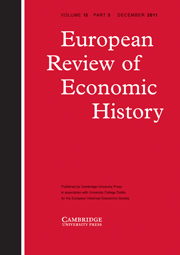Article contents
Steps toward equality: How and why income inequality in urban Sweden changed during the period 1925–1958
Published online by Cambridge University Press: 16 October 2003
Abstract
This article aims to throw light on why inequality in the distribution of income in Sweden fell from the mid-1920s to the second half of the 1950s. A new database has been created by coding tax records and other documents for the city of Göteborg. In the analysis the Gini-coefficient and its changes are decomposed by income source. The information shows that in the mid-1920s income in urban Sweden was fairly unequally distributed. The compression of the income distribution came about as real income at the lower end increased rapidly, while the real income of the most affluent decile remained more or less constant. Much of the initial decrease in income inequality was due to capital income decreasing in average size and in addition becoming less extremely concentrated at the top of the income distribution. From the mid-1930s onward households paid ever larger shares of their income as income taxes which caused income inequality to decrease.
- Type
- Research Article
- Information
- Copyright
- © 2003 Cambridge University Press
- 12
- Cited by


